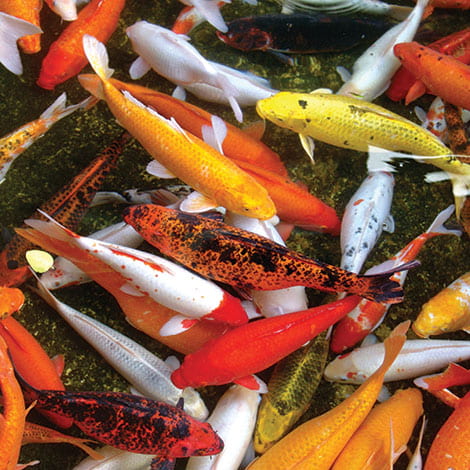Asked By: Jeri, Hartsville, SC
A: It's easy to spend hours online ogling champion koi. The fishes' near-perfect silhouettes, vivid color palettes and balanced scale patterns – not to mention their size – inspire hobbyists to go on their own quests for the Holy Grail of pond fish. So they search pet store aquariums. They peruse tanks at their local pond supplier. They even eye their friends' fishes, finding themselves coveting a golden butterfly or a sparkly gin rin kohaku.
Does this sound familiar?
Unfortunately, championship-quality koi are rare, as are some of the hard-to-find varieties. The good news, however, is that all koi are unique, and each variety has its own distinct color combination, scale pattern and physical characteristics. They're called "living jewels" for a reason!
Read on to learn more about the different koi varieties – and how to find the exceptional ones.
Colorful, Common Koi
Most pet stores and pond supply shops stock the most
popular varieties of koi, including these, below.
- Kohaku: These fish have a solid white body overlaid with large red markings (hi). Top quality Kohaku display a bright, blemish-free white combined with deep, vibrant red patterns that are evenly distributed along the body.
- Sanke (Taisho Sanke): These koi look similar to Kohaku, but they also have small black markings (sumi) overlaid on its white base. Experts say a high quality Sanke pattern begins with a great Kohaku pattern, to which the black is a welcome complement.
- Showa (Showa Sanshoku): Commonly known as Showa, these fish have a solid black body that's topped with red and white (shiroji) markings. Showa can be confused with Sanke; the difference is that in Showa, the black patterns wrap all the way around the body and appear on the fish's head. The red, white and black should be evenly balanced, with crisp, clean edges between each color.
- Ogon: Their metallic scales are in one solid color, typically yellow (Yamabuki Ogon) or white (Platinum Ogon). A clean solid-color head and unblemished body are crucial to a high-quality Ogon.
Exceptional Specimens
If you want to add some rarely seen jewels to your pond, check out these varieties below. Though you may find them at your local retailer, you'll have better luck sourcing them via online vendors and koi auctions.
- Shusui: Shusui are the scaleless (doitsu) version of Asagi, which are koi that display a blue net-like pattern on the back that's complemented by red or orange patterns on the body. In Shusui, the blue net pattern is replaced by a single row of scales along the dorsal line at the top of the back.
- Kumonryu: Another scaleless variety, Kumonryu have patterns of grey or white combined with black. They will completely change their pattern many times throughout their life. They can go anywhere from solid white to solid black, or any conceivable combination in between.
- Tancho: Tancho is a popular variation of Kohaku, in which the only red pattern appears as a single red dot on the head. The symmetry and placement of the Tancho mark are main factors in determining the quality of any particular koi.
Whether choosing a common or uncommon variety, look for bright colors, crisp edges and interesting patterns. The koi's color vibrancy and pattern edges will change over time (dramatically, in the case of the Kumonryu!), but its variety will stay the same; a Kohaku, for instance, won't change into a Showa.
Nutrients in your koi's food can affect its color display, so be sure to feed them some
Growth & Vibrance Fish Food, it contains spirulina and stabilized vitamin C for show-stopping color.

